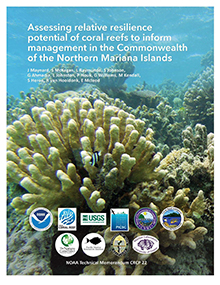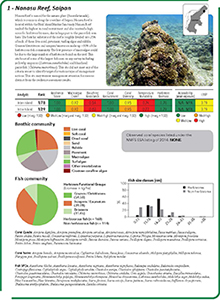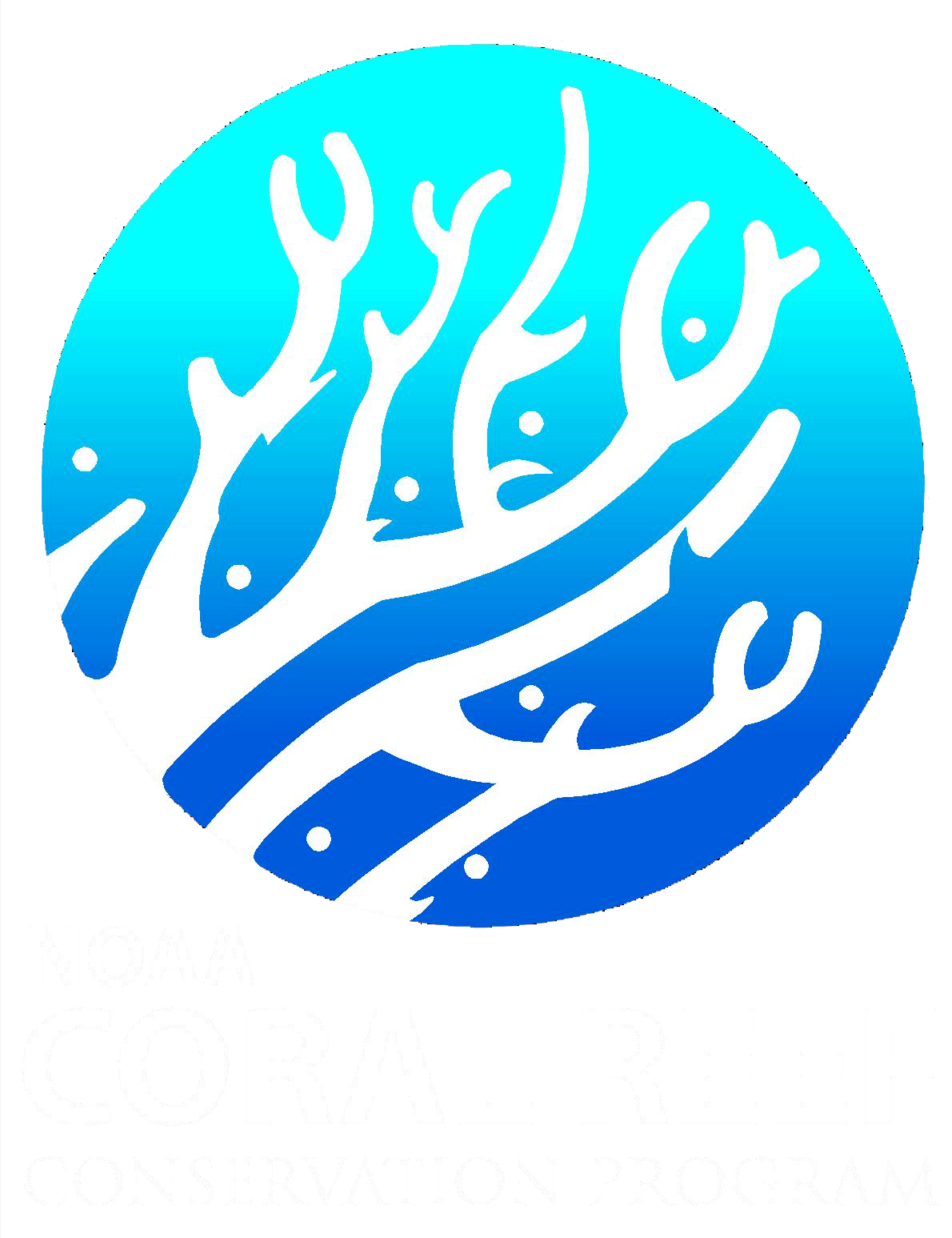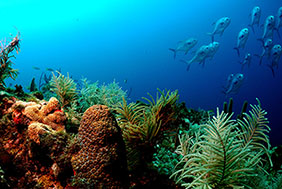-
Home
-
Data & Publications
-
Regional Portals
- About Regional Portals
- Florida
- Navassa Island
- Puerto Rico
- Flower Garden Banks
- U.S. Virgin Islands
- American Samoa
- Commonwealth of the Northern Mariana Islands
- Federated States of Micronesia
- Guam
- Main Hawaiian Islands
- Republic of the Marshall Islands
- Northwestern Hawaiian Islands
- Republic of Palau
- Pacific Remote Island Areas
-
CRCP Activities
- Glossary
Assessing relative resilience potential of coral reefs to inform management in the Commonwealth of the Northern Mariana Islands
Field-based Assessments and Implications for Vulnerability and Future Management
Coral reef managers face the challenge of reducing vulnerability to the effects of climate change by reducing other sources of stress to support the resilience of reef systems. Resilience-based management (RBM) has been developed to overcome the challenges of reducing vulnerability in this era of rapid change. RBM of coral reefs can include assessing spatial variation in resilience potential and then targeting and tailoring appropriate actions, which is the focus of the project reported on here.
In CNMI, undertaking resilience-based management became a priority following a bleaching event in 2000, which caused 60-70% coral mortality in some locations, and a less severe bleaching event in 2005 that coincided with an outbreak of crown-of-thorns starfish. Reef managers in CNMI became especially interested in identifying bleaching-vulnerable locations between 2009 and 2011. During these years the NOAA Coral Reef Watch tools suggested severe bleaching was possible. Fortunately, waters never warmed over reefs sufficiently to cause thermal bleaching between 2009 and 2011 due to high cloud cover and rainfall. This project then began in 2012 with surveys of 35 lagoon and forereef sites near Saipan, which was followed by identifying bleaching-vulnerable locations and ranking sites from highest to lowest relative resilience potential. In the process used for the resilience assessment, values for variables that are indicators of resilience processes ('resilience indicators' - e.g., herbivory and recruitment) are compared to the maximum value for that indicator among the survey sites. This means that in 2012 we could only compare the sites we surveyed near Saipan. The project reported on here sought to expand the surveys and analysis undertaken in 2012 so that coral reef sites near all of the populated islands in CNMI could be compared. In total, in May/June of 2014, 49 more sites were surveyed at the 30-foot contour near the islands of Tinian and Aguijan as well as near Rota. A large number of other changes and additions were made for this project that advance our work from 2012. The most important of these are that: anthropogenic stressors are examined separately to the resilience indicators, the assessments of resilience indicators and anthropogenic stressors are summarized within a decision-support framework that targets management actions to support site and system resilience, and connectivity simulations are used to interpret the resilience assessment results and further prioritize and target management actions.
Study Objectives:
- Benthic Cover and Disease- Assess the % cover of major benthic groups and coral disease prevalence
- ESA-listed Coral Species - Identify coral species listed as Threatened under the 2014 ESA listing
- Relative Resilience - Assess resilience potential of forereef sites within and among the surveyed islands
- Resilience Drivers - Determine primary drivers of differences in resilience potential
- Connectivity - Assess the extent to which each surveyed island is a source and destination of larvae
- Assessing Anthropogenic Stressors and Identifying Management Targets - Identify priority areas to target management actions that can support reef resilience
- Outreach and Engagement - Ensure project results are accessible to local managers in CNMI, understood, and used to inform management decisions and planning
Summary Conclusions

Obj. 1 - Benthic Cover and Disease: The average percent cover of live coral and macroalgae were similar in Saipan and Tinian/Aguijan; ~38% for live coral and ~7% for macroalgae. On average, coral cover was ~10% lower on Rota than in Saipan or Tinian/Aguijan (~28% versus ~38%) and macroalgae cover on Rota was twice that observed in Saipan or Tinian/Aguijan (~14% versus ~7%). The average coral cover at the forereef sites (all islands combined) is 35%, which is slightly greater than the current average coral cover in the Great Barrier Reef in Australia. Coral disease prevalence is low and typically ~3% in Tinian/Aguijan and Rota. The most commonly observed coral diseases are white syndromes and skeletal eroding band.
Obj. 2 - ESA-listed Coral Species: There are three coral species newly listed in 2014 as Threatened under the Endangered Species Act that are known to be present on reefs within CNMI: Acropora globiceps, Acropora retusa, and Seriatopora aculeata. We compiled complete coral species lists for all survey sites and only A. globiceps was observed during our surveys. A. globiceps was observed at one site in Saipan, at 13 of the 24 survey sites in Rota and at 12 of the 25 survey sites in Tinian/Aguijan. A. globiceps was also observed at 3 shallow (<4 m) sites in northeast Tinian (only shallow sites surveyed outside the Saipan lagoon), one of which is a planned focus of future military training activities (Unai Chulu).
Obj. 3 - Relative Resilience: Resilience potential varied greatly within and among islands with some sites having high and some having low relative resilience potential. Generally, sites closest to the main population centers and near cleared lands had lower relative resilience potential than sites more remote from population centers. Since anthropogenic stressors are examined separate to the ecological resilience assessment, these results strongly suggest human activities are impacting the resilience potential of coral reefs near population centers.
Obj. 4 - Resilience Drivers: Herbivore average functional group (AFG) biomass and coral recruitment are the indicators that most distinguish sites in the resilience assessment from one another. These influential indicators need to continue to be assessed during research and monitoring activities. The processes these indicators measure are inter-related since herbivores clear algae from the substrate upon which coral recruits can then settle. Consequently, both are positively affected by actions that conserve herbivorous fish.
Obj. 5 - Connectivity: There is great variation among the islands in the extent to which each is a source and destination for fish and coral larvae. The connectivity simulations indicate Saipan is roughly twice as great a source as Tinian and 10x that of Rota. Tinian and Saipan are comparable destinations and each is roughly twice as great a destination as Rota. These results help explain the lower relative resilience potential of reefs in Rota. These results also strongly suggest that actions taken to support the resilience of reefs in Rota may not be sufficient to overcome the limitations for recovery potential in Rota due to Rota having poor connectivity with the other large islands in the Marianas chain. Therefore, actions to support resilience are likely to be more effective in the long-term if implemented in Saipan and Tinian/Aguijan.
Obj. 6 - Assessing anthropogenic stressors and identifying management targets: 55 of the 78 forereef survey sites met at least one of the 6 criteria we set to identify targets for management actions that can support site and system resilience. We identified targets for: conservation, land-based sources of pollution reduction, fishery management and enforcement, bleaching monitoring and supporting recovery, reef restoration/coral translocation, and tourism outreach and stewardship. The criteria for the data queries we set are an innovation in streamlining how the results of ecological resilience assessments can inform management actions. Managers in CNMI can use the connectivity results as well as our observations of the Threatened coral species Acropora globiceps to further prioritize from among the identified sites. For example, actions in Saipan and Tinian/Aguijan may be more effective so can be prioritized (as above) and efficiencies can be gained for managers by supporting resilience at sites that meet one or more of the set criteria and have resident A. globiceps colonies.
Obj. 7 - Outreach and engagement: The results of this project have already been shared through presentations to local managers in CNMI, as well as regionally and globally via recorded webinars. In all, a wealth of data and information were produced during this project that can inform management decision-making and planning in CNMI for years to come. In this sense, a part of the project is just starting in that efforts will be ongoing for the years ahead to maximize the value of the data and results for supporting the resilience of CNMI's diverse coral reefs.
This project report: provides further background both to this project and ecological resilience assessments in reef areas, describes our methods for assessing the various resilience indicators and anthropogenic stressors, shares highlights of our results and progress towards each of the objectives, identifies next steps, and has an appendix with tables and map graphics that expand upon the content within the main report. This report includes Site Summaries; 1-page overviews for each of the 84 sites we surveyed of the field data, resilience assessment results and the results of the queries that identify targets for various types of management actions.Citation
Maynard, J., S. McKagan, L. Raymundo, S. Johnson, G. Ahmadia, L. Johnston, P. Houk, G. Williams, M. Kendall, S. Heron, R. van Hooidonk, and E. McLeod. 2015. Assessing relative resilience potential of coral reefs to inform management in the Commonwealth of the Northern Mariana Islands. Silver Spring, MD: NOAA Coral Reef Conservation Program. NOAA Technical Memorandum CRCP 22. 153pp. doi:10.7289/V5H41PFM
Related Resources
Acknowledgements
Financial support for this applied research was provided by the NOAA Coral Reef Conservation Program, USGS via the Pacific Islands Climate Science Center, Western Pacific Coral Reef Institute via the University of Guam, Senator Gregorio Kilili Sablan Funding in CNMI, and by the European Research Commission. Project planning and implementation benefited from collaboration with the CNMI Bureau of Environmental and Coastal Quality and MINA.
For more information contact:
NOAA's Coral Reef Conservation Program
301-713-3155
coralreef@noaa.gov


